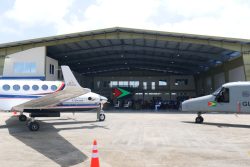Agriculture Minister Noel Holder says that the Guyana Sugar Corporation (GuySuCo) projects consecutive yearly increases to its sugar production from 2019 through 2021.
Holder announced this yesterday, during his contribution to the 2018 budget debate.
“Mr. Speaker, 2018 is the first year in which the sugar industry production has been restricted to three operating factories – Albion, Blairmont and Uitvlugt. Production from these have been significantly strong[er] than that achieved in 2017 when the combined output was 88,000 tonnes of sugar,” Holder said, while stating that the Ministry and the sugar company are confident that they will surpass their current production target of 103,000 tonnes.
He explained that during this year, the estates were able to improve their productivity, with a resultant increase in overall sugar production as a result of good agricultural practice, more efficient timing of operations, improved attention to detail and the addition of engineering support to the factories.
As a result, the sugar industry’s strategic plan for 2018 to 2021, projects a production of 113,262 tonnes of sugar next year, approximately 131,000 tonnes of sugar in 2020 and 141,431 tonnes by 2021.
Noel added that in order for the projections to be achieved, capital investments of over $17 billion will be made in the next three years in a timely manner to ensure the security of production and to maximise the quality of the end production.
Holder also pointed out that severance has been paid to all employees that were retrenched at the end of 2017 and while the Wales workers who were severed a year earlier are yet to receive their payment, he is hopeful that by the end of the week they will be able to receive their long awaited payments.
He also touched on the rice industry and stated that a projection of a 1.9% increase is noted, bringing the total expected production to 642,210 metric tonnes for the year.
“This is due to improvement in yields and transferring better agronomic and management practice to rice farms. As of November, paddy figures were at 957,739 metric tonnes with farmers receiving as much as $3,300 per bag in Regions Four and Five,” he said, while pointing out that for next year, rice production is expected to increase by a further 1%, bringing the total to approximately 645,456 metric tonnes, while exports are also expected to increase.
He said that currently, the rice industry is tapping into markets from 34 different countries in CARICOM, the European Union, Latin America and West Africa, the latter having been tapped into this year. He added that they are expecting to explore two more markets in 2019.
“In 2018, the GRDB [Guyana Rice Development Board] release[d] a new high yielding variety – GRDB 50 – with approximately 2,497 hectares sown in the second crop,” he said, while pointing out that the national yield has increased to 91 bags per hectare, which translates to 37 bags per acre.
Holder further added that through the Malaysia Rice Production Reverse Linkage project, they will be producing high quality seeds of international specifications by establishing a national seed certification programme, and will also be producing three new varieties.








